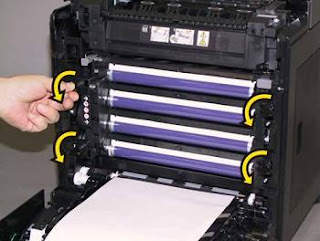Determine the paper specifications that were used
A4, A5, B5, Letter, Executive, Folio, Legal, Com-10, Monarch, DL, C5
Gently Clean the Feed Roller Inside the Printer
1. Remove the paper tray
2. Push the side button and open the front cover
3. Open the transfer belt
4. Put a piece of paper over the transfer belt in order to protect it.
5. Rotate the four stoppers of the PHD unit to the counter clock wise direction, to release the lock

6. Grasp the left and right handles and pull the PHD unit toward you
7. Once the PHD unit is clear of the housing, lift it up from the printer.
8. Clean the feed roller inside the printer with a dry cloth
9. To complete this operation, perform steps 1 through 7 in reverse.




